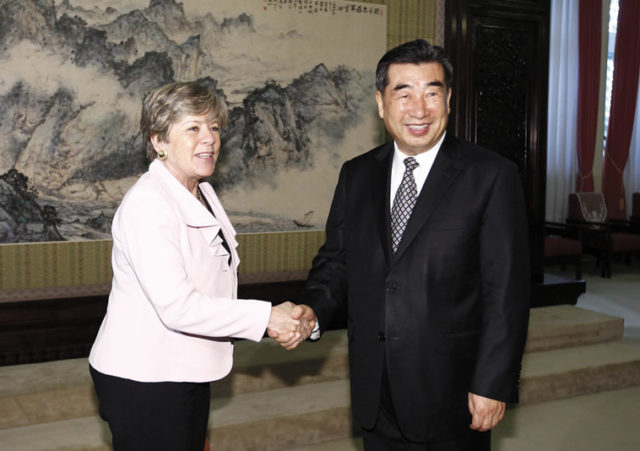China’s relationship with Latin America, like its relationship with Africa, represents an important aspect of the country’s growing and more confident engagement with the developing world. As in Africa, China has vastly increased its trade and investment in Latin America, but the relationship stirs less controversy than do China’s ties with Africa.
When China entered the World Trade Organization in 2003, annual trade between China and Latin America amounted to just US$14.4 billion. By 2012, this had risen to US$255.5 billion, which was also an eight percent increase on 2011. Sino–Latin American trade now grows faster than US trade with Latin America — which only increased 6.2 percent from 2011 to 2012 — although the volume of US trade with Latin America is still three times larger than that of China.
Latin American exports to China largely consist of raw materials such as oil (Venezuela), copper (Chile), iron ore (Brazil), and soybeans (Brazil and Argentina). Latin America, in turn, imports from China electronic items, equipment and machinery, auto parts and textiles. While there are parallels between the two, a significant difference between Sino–African and Sino–Latin American trade is that Latin America maintains a substantial trade deficit with China: US$150 million in 2011 and blowing out to a full US$6.6 billion in 2012. This illustrates how challenged Latin American manufacturers are in their home markets by Chinese imports. Over recent years, there have been sporadic protectionist moves in Latin America. For example, in September 2011, the Brazilian finance minister announced a thirty-point increase in the country’s industrial product tax on imported cars in an attempt to stem the increasing flow of Chinese automobiles into the local market.

Alicia Bárcena, executive secretary of Comisión Económica para América Latina y el Caribe (CEPAL), meeting with Vice Premier Hui Liangyu.
Source: CEPAL ONU
China’s investment strategy in Latin America echoes its approach to Africa, although exact data is impossible to compile due to the fact that most Chinese investment in Latin America flows into tax havens such as the Cayman Islands and the British Virgin Islands. Nevertheless, according to the Economic Commission for Latin America and the Caribbean, as much as ninety percent of China’s confirmed investments in Latin America up to 2011 were aimed at the extraction of natural resources. Other targeted sectors include the automotive, financial, and chemical. Figures released at the Fifth China–Latin America Business Summit (an approximate Latin American equivalent of the Forum on China–Africa Relations) claimed that by the end of 2011, China’s total investment in the region was approximately US$23 billion. Yet according to a dataset compiled by the conservative US-based think tank the Heritage Foundation, Latin America received only 3.9 percent of total Chinese investment in 2011–2012, with the vast majority of that going to Brazil.
Since 2010, China has attempted to diversify its investments in Latin America to include deals in the manufacturing, infrastructure and services sectors. The Chinese tech firms Huawei, ZTE and Lenovo have become prominent investors in Latin American telecommunications and electronics, but other companies are involved as well. In February 2010, for example, Sany Heavy Industry, one of China’s largest construction equipment manufacturers, ploughed US$200 million into a factory in the Brazilian state of São Paulo. The Chinese auto manufacturers Zhongxing, Geely and Changan have all established auto manufacturing plants in Mexico. And China’s ZTE has started producing smartphones in Argentina together with local white goods manufacturer BGH, and plans to make tablet computers in Brazil.
In recent months, both US and Chinese leaders have toured Latin America. President Barack Obama visited Mexico and Costa Rica in May, and Vice President Joe Biden called in on Colombia, Trinidad and Tobago and Brazil. Just after Biden left the region, China’s President Xi Jinping toured Trinidad and Tobago, Costa Rica and Mexico. An op-ed in the China Daily in June 2013 gloated:
During his visit to Latin America and the Caribbean, President Xi offered more than $5.3 billion in financing, with few conditions attached, to its newfound Latin American friends … . Making available this financing comes on top of the already $86 billion in financing provided by China to Latin American governments since 2003. Simply put, the US and the array of largely Western-dominated international financial institutions have been surpassed by China’s financial strength … . Welcome to the brave new world!
A current point of contention is a controversial Chinese project in Nicaragua, where a Chinese company aims to build the ‘Nicaragua Canal’ — a proposed waterway through Nicaragua that would connect the Caribbean Sea and Atlantic Ocean with the Pacific Ocean. A newly registered Hong Kong company, HKND Group, was officially awarded the concession agreement in June giving it the rights to construct and manage the canal and associated projects for fifty years. HKND is led by Wang Jing, who runs the company Xinwei Telecom and denies any connection with the Chinese government. The massive US$40 billion project gained approval from Nicaragua despite criticism from environmental groups and widespread scepticism about its economic viability. Once the project commences, it will take Chinese involvement in the region to a new height and, in the words of China Daily, usher in a brave new world.


